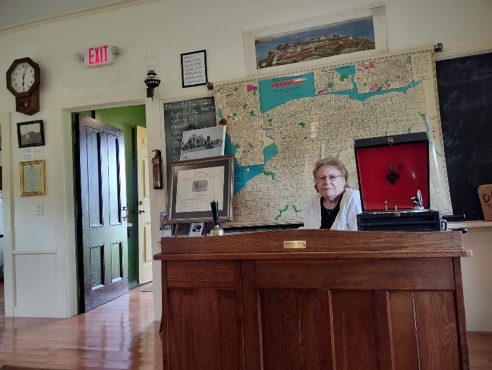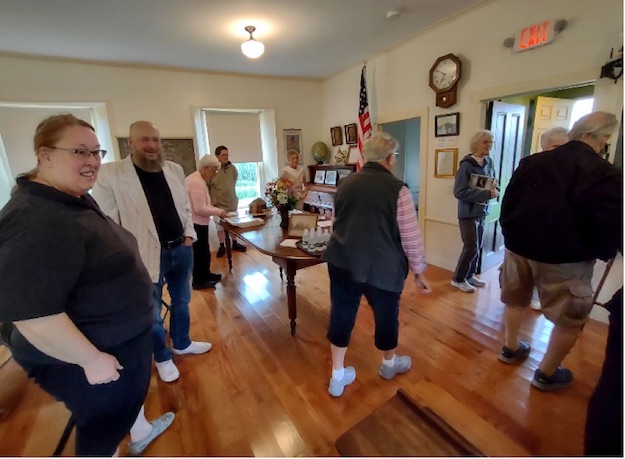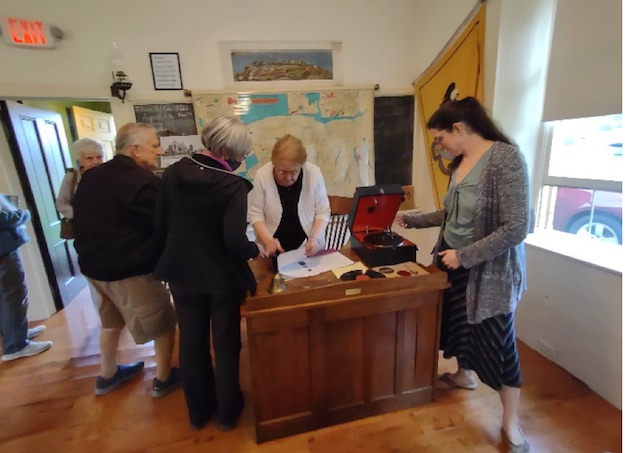Gaines Basin cobblestone school hosts first public event since interior remodeled
Historian shares about Caroline Phipps, who started a school for women in Albion

Photos courtesy of Melissa Ierlan: Dee Robinson, retired Town of Gaines historian, gave a presentation on Sunday evening about one of the teachers at the schoolhouse, Caroline Phipps, who would start the Phipps Union Female Seminary in Albion.
Courtesy of Melissa Ierlan
GAINES – The first public event held at the Gaines Basin cobblestone school since the interior was remodeled was held on Sunday evening was completed.
Dee Robinson was the speaker and gave a presentation about Caroline Phipps Achilles and the Phipps Union Seminary. The lecture was part of a series by the Orleans County Historical Association each Sunday at 6 p.m. during August.
Dee Robinson moved to Childs in the 1970s. She joined the Cobblestone Society and organized its resource center. She became the deputy historian of Gaines, then the historian. She served in the position for over 30 years. Robinson currently works at the Hoag Library in the local history room.
Her focus during Sunday’s lecture was Caroline Phipps and the Phipps Union Female Seminary. Phipps was born in 1812. By age 14 she was teaching school in a log shanty in Gaines Basin for $1 a week. The log shanty was 14’ x 16’ with a stone chimney and a crude fireplace. She worked each day from 7 a.m. until noon then from 1 p.m. until 6 or 7 p.m. Seats were made of slab logs; tables were pinned against the walls. Every square inch of space was occupied.
By 1832 the cobblestone school house was built. At this point Caroline left teaching for more education. After she returned, she desired to establish a women’s school. Phipps Female Women’s Seminary was founded in 1837. By 1851 a wing was added on to the building to serve as housing for 100 students.

The Gaines Basin schoolhouse, which has undergone major interior upgrades in recent years, hosted its first public event on Sunday.
Girls who attended the Phipps seminary came from many different states including Michigan, Vermont, Indiana, Illinois, Kentucky and even from Canada. Each student was required to have a Bible and attend a church every week that their parents had chosen.
Dee made several connections during her research into Caroline Phipps and the seminary. She spoke of a phone call from a relative of a woman who had attended the seminary and graduated in 1861. She offered to send the certificate from her graduation. The woman’s name was Miss Gertrude Ward. Dee discovered in the library’s collection, a program from the same year Ward graduated. Frank Lloyd Wright’s father wrote a ballad in 1847 for the Phipps Union Seminary. Lillian Achilles was the first librarian of the Swan Library and was the great niece of Caroline Phipps.
The school had two fires in 1874 and 1875. The second fire destroyed the building and the school ceased operating. The county bought the parcel upon which the County Clerk’s Office was constructed and still remains.

Dee Robinson and some of the attendees look over artifacts at the school.







































































